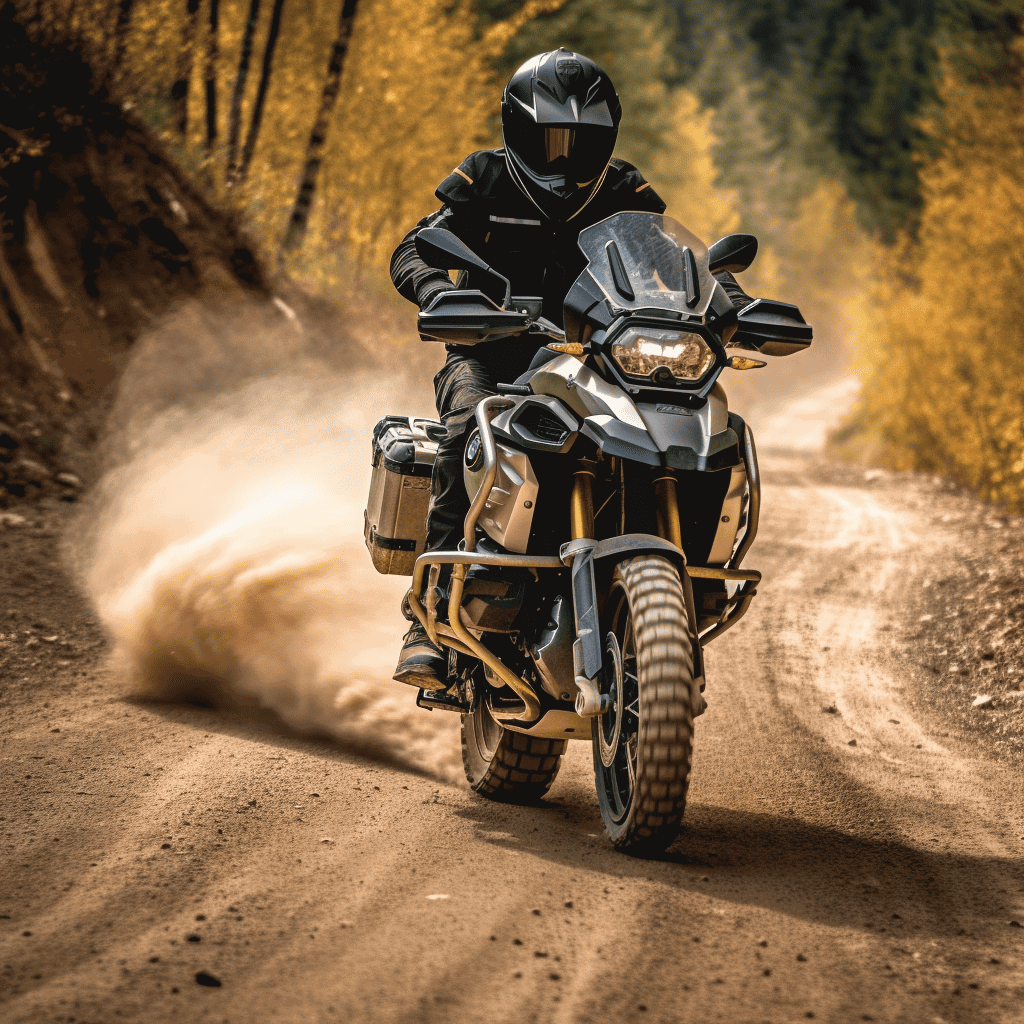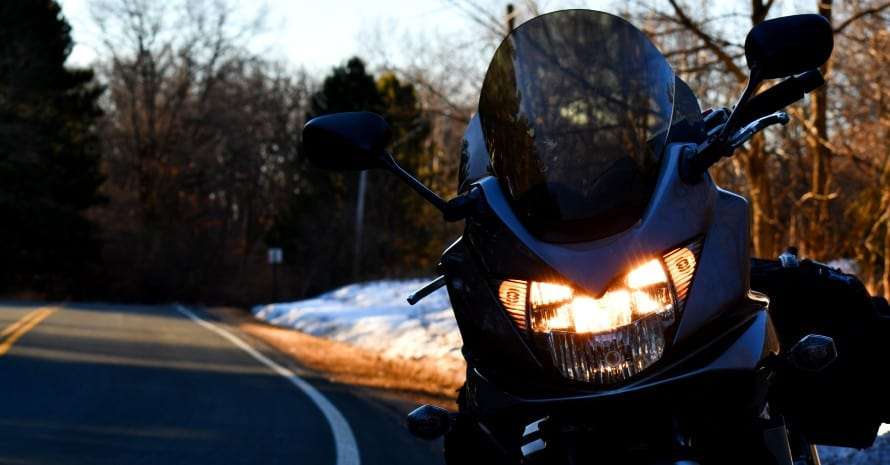This is one of the most debatable subject and one that is not really well understand. Why? First, there is the translation of feelings to words that can be, at the very least, not really clear. Second, there is all the people that know how to drive but that can’t explained it clearly. Then, there is the kind of people that are simply wrong and finally there is the good student that only report one of the above without understanding.
I have followed two adventure driving courses and they both have different point of view on the subject Off-Road Adventure academy state that you should weight the outside pegs and Formation Adventure Quebec stated that we should weight the inside pegs…That’s where my confusion begin, so I had to dig all the information that I can on the subject and I want to share it with you.
In fact, there is only one way to weight the pegs off-road and it’s this one: When off-road riding motorcyclist should attempt to weight the outside pegs. Doing this, you will achive two things, you will reduce the slipping angle between the front and the rear tire and you will maintain most of your weight over the contact patch.
In the next few lines I will try to explain one of the most debatable point on off-road driving and in the meantime will make you a better and safer off-road rider. You will not find a better study anywhere I promise.
Table of Contents

Foot pegs weighting and slip angle
Slip angle is a concept in vehicle dynamics used to analyze the behavior of a vehicle in a turn. It’s defined as the angle between the direction in which a wheel is pointing and the direction in which it is actually moving. This concept is not limited to cars but also applies to motorcycles.
Here’s a simplified explanation:
Imagine a motorcycle moving straight ahead. In this case, the direction in which the wheels are pointing and the direction of their movement are the same, so the slip angle is zero.
Now, imagine the motorcycle starts to turn. To initiate the turn, the rider countersteers slightly, pushing the handlebar on the side they want to turn towards. This makes the bike lean in the desired direction. The rider then steers into the turn, which creates a slip angle. The wheels are pointing towards the inside of the turn, but because of the bike’s momentum and the forces acting upon it, they’re actually moving along a path that’s slightly to the outside of where they’re pointing. The slip angle is the difference between these two directions.
In other words, the slip angle on a motorcycle (or any vehicle) is a measure of how much the vehicle is drifting or sliding laterally in a turn.
It’s important to note that a certain amount of slip angle is normal and necessary for a vehicle to turn. However, if the slip angle becomes too large, the tires can lose grip, leading to a slide or skid. So in trying to reduce the slip angle, you are effectively making the motorcycle less likely to slip.
Also, keep in mind that slip angle is a somewhat complex concept that involves various factors like tire characteristics, weight distribution, speed, and more. It’s one of the key parameters used in the design and analysis of vehicle handling characteristics, but it’s not something that most riders or drivers need to think about in day-to-day driving or riding.
As I was searching for information on this subject, one of the more informative piece of content came from a interview of Chris Birch (Professional KTM riders) and Mark Nesbit (NASA Rocket scientist). I guess they know more on driving and physics than me.
Weighting the outside pegs will decrease the slip angle
Applying force to the outside footpeg during a turn can affect the slip angle and the overall dynamics of the motorcycle. When you apply force to the outside footpeg, you’re essentially shifting your weight to the outside of the turn. This can have a couple of effects:
- It can help keep the bike upright: On loose surfaces like gravel or sand, applying force to the outside footpeg can help to keep the bike more upright, which can reduce the risk of the tires sliding out from under you.
- It can potentially decrease the slip angle: By keeping the bike more upright and the tires more directly underneath you, applying force to the outside peg can help to decrease the slip angle, which can increase the amount of grip the tires have. This can make it easier to control the bike and prevent it from sliding.
However, it’s important to remember that applying force to the outside footpeg is generally more effective on loose or slippery surfaces. On hard surfaces like pavement, applying force to the inside footpeg can be more effective for controlling the bike during a turn.
Additionally, the effects of applying force to the footpegs can vary depending on a number of factors, including the type of motorcycle, the type of tires, the rider’s skill level, and the specific riding conditions. It’s always a good idea to practice new techniques in a safe, controlled environment before trying them out on the open road or trail.
Is the slip angle of the front and back wheel the same?
In most cases, the slip angles of the front and rear wheels on a motorcycle are not the same, especially when the bike is cornering.
During a turn, the front wheel generally has a larger slip angle than the rear wheel. This is primarily because the front wheel is responsible for steering and thus, is turned more sharply into the corner, while the rear wheel follows a more gradual path. This is why you often see the front wheel of a motorcycle pointing in a slightly different direction than the path the bike is actually taking.
However, it’s important to note that the difference in slip angles between the front and rear wheels can change based on various factors. For instance, if the rider applies the throttle during a turn, this can cause the rear wheel to spin faster and create a larger slip angle. Similarly, if the rider brakes during a turn, this can increase the slip angle of the front wheel.
Ultimately, the goal in managing slip angles is to maintain control and stability. Too large a slip angle can cause a loss of traction and lead to a skid or slide, while too small a slip angle can make the bike less responsive. Understanding how different actions affect the slip angles of the front and rear wheels can help you become a more skilled and safer rider.
What is the effect of counter-steering on the slip angle?
Countersteering is the technique used to initiate a turn on a motorcycle, where the rider briefly steers in the opposite direction of the turn to cause the bike to lean in the desired direction. Once the lean is established, the rider then steers into the turn.
When you countersteer, regardless of the surface, you initially increase the slip angle of the front wheel. This is because you’re turning the wheel in one direction while the bike continues to move in a mostly straight line due to momentum. This creates a difference between the direction the wheel is pointing and the direction the bike is moving, which is the slip angle.
On a loose surface like gravel, the slip angle might be larger than it would be on a hard surface because the wheel can slide more easily. This can make the bike feel less stable and more difficult to control.
However, once you’ve initiated the turn and start steering into it, the slip angle will typically decrease. This is because the bike’s path of motion becomes more aligned with the direction the front wheel is pointing. If you’re applying weight to the outside peg and maintaining a steady speed, as recommended for riding on loose surfaces, this can also help to reduce the slip angle and maintain traction.
Remember, countersteering is a skill that requires practice to master, especially on loose surfaces. Always ride within your limits and wear appropriate safety gear. I have try a nice and budget friendly adventure kit, you can have more information here HWK Motorcycle Jackets and Pants: A Comprehensive Review.
As you can see on this video with Brett, weighting the pegs can be seen from different points of views, but it’s pointing in the same direction as me and my buddy (I wish) Chris Birch.
What is the effect of the tire pressure on the slip angle?
Reducing tire pressure can increase the size of the tire’s contact patch with the ground, which can potentially improve traction, especially on loose or soft surfaces. This, in turn, could potentially reduce the slip angle by making it less likely for the tire to slide or drift during a turn.
However, while reducing tire pressure can provide more traction in certain conditions, the impact on the slip angle may not necessarily be significant and will depend on various factors, including the type of surface, the specific tire, the motorcycle’s speed, and the rider’s technique.
Moreover, it’s important to understand that there are also potential downsides to reducing tire pressure. For instance, under-inflated tires can heat up more quickly, you can bent the rim if you hot a rock, which can lead to premature wear and even tire failure. They can also make the bike feel less stable and more difficult to steer, especially at higher speeds on hard surfaces.
Therefore, if you’re considering reducing your tire pressure for off-road riding, it’s important to do so carefully. Make sure not to deflate the tires too much, and always re-inflate them to the manufacturer’s recommended pressure before riding on pavement or at high speeds.
Remember, improving your riding technique and understanding of vehicle dynamics will likely have a much greater impact on your ability to control the motorcycle and manage the slip angle than minor adjustments to tire pressure.
How the position of my body influence the motorcycle?
When riding a motorcycle off-road, the aim should be to keep your center of gravity (which is heavily influenced by your body weight) over the center of the bike to help maintain balance. Depending on the terrain and the specific circumstances, you might shift your weight forward, backward, or side to side to help control the bike.
For turns on loose surfaces, you might often hear the advice to keep your weight on the outside peg and your body upright, even if the bike leans into the turn. This can help to keep the contact patch of the tire squarely on the ground, providing the maximum possible traction.
However, there can be situations where you would want to shift your weight off the centerline of the bike. For example, when going uphill on a steep incline, you might lean forward and shift your weight to the front to prevent the bike from tipping backward. Similarly, when going downhill, you might shift your weight to the rear to prevent the bike from tipping forward.
In summary, the idea is not necessarily to keep your body weight directly above the contact patch of the tire at all times, but to actively manage your weight distribution to maintain control of the bike in a variety of off-road conditions. This is a skill that requires practice and experience to master.
Is there other school of tought?
You can listen to the video of Ariemann1 another really good rider here and it’s pointing in the same direction but with different words. In the first video he is explaining control drills with slalom around 2:30 and in the other one he’s explaining how to corner at speed.
While on Youtube you can also check this video that is completely in an opposite direction. I have watch it a couples of times but it doesn’t make sense from the physics perspective…But you must admit the bloke as a great accent.
Finally there is this video from Mototrek where Dusty is explaining cornering very well. Dusty is on fire on this one.
FAQ
Is it true that riding a motorcycle on and off road use the same techniques?
While the motorcycle in itself is the same, you will quickly drop your motorcycle off-road if you try to corner off-road as you do on asphalt. The major difference between on road and off road is the stability of the surface you are riding on. Usually off-road include soft terrain, sand, gravel, rock or mud. Those surfaces imply that you adapt your driving technics.
What is slip angle in the context of motorcycle riding?
Slip angle is the difference between the direction in which a wheel is pointing and the direction in which it is actually moving. In motorcycle riding, this concept comes into play especially during cornering.
Are slip angles the same for the front and rear wheels?
Typically, no. When cornering, the front wheel usually has a larger slip angle than the rear wheel, because it steers more sharply into the turn while the rear wheel follows a more gradual path.
How does countersteering affect slip angle?
Countersteering is used to initiate a turn by briefly steering the bike in the opposite direction of the desired turn. This increases the slip angle of the front wheel initially, but once the bike leans into the turn and the rider steers in the direction of the turn, the slip angle generally decreases.
How does tire pressure affect slip angle?
Reducing tire pressure can increase the size of the tire’s contact patch with the ground, potentially improving traction and reducing slip angle. However, the impact may not be significant and depends on various factors, such as the surface type, tire, speed, and riding technique.
How does weight distribution affect slip angle in off-road riding?
Weight distribution can significantly impact slip angle and the overall handling of the motorcycle. On loose surfaces, applying weight to the outside footpeg can help keep the bike more stable and upright, which can reduce the slip angle and help maintain traction.
Is it true that my body weight should stay on top of the contact patch of the tire when riding off-road?
While maintaining your center of gravity over the center of the bike helps with balance, off-road riding often requires actively managing your weight distribution to maintain control of the bike in various conditions. In turns on loose surfaces, keeping your weight on the outside peg and your body upright can help maintain maximum traction.
How can I reduce slip angle when riding off-road?
Maintain a steady speed, avoid abrupt acceleration and deceleration, apply weight to the outside footpeg during turns, and consider adjusting tire pressure for the specific terrain. Always remember that proper riding technique is key, and practice is essential to mastering control of slip angles.
Conclusion
When riding, we want to reduce the difference between the slip angle of the back and front wheel. This will in turn change the forces applied to the contact patch and make the motorcycle less likely to slip. So weighting the outside pegs is more efficient mostly because it permit to keep the body upright (applying more force to the ground) and it also produce torque (rotational pressure on the motorcycle) and this torque is likely to reduce the slip angle. Yeah I know you have a headache now…Welcome to my world. Why is it that every time I have a question I must learn as much as I can on it? So many night have been lost trying to find answer to unimportant questions. 🙂

Meet Simon, the 46-year-old aficionado behind YourMotoBro. With a lifelong passion ignited by motocross dreams and a Canadian Tire bicycle, Simon’s journey has been nothing short of extraordinary. From coaching underwater hockey to mastering muddy terrains, he’s an authority in thrill and adventure. Certified as an Off-Road Vehicle Excursion Guide and trained in Wilderness First Aid, Simon’s love for bikes is as diverse as his collection—from a robust BMW GSA R1200 to the memories of a Harley Davidson Night Train. By day a respected telephony consultant, by night a motorcycle maestro, Simon’s tales are a blend of expertise, resilience, and undying passion. ?️✨
